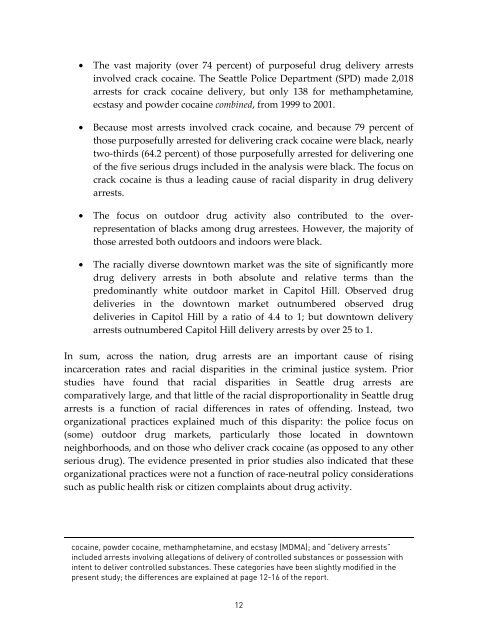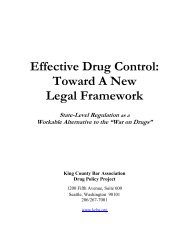RACE AND THE ENFORCEMENT OF DRUG DELIVERY LAWS IN ...
RACE AND THE ENFORCEMENT OF DRUG DELIVERY LAWS IN ...
RACE AND THE ENFORCEMENT OF DRUG DELIVERY LAWS IN ...
You also want an ePaper? Increase the reach of your titles
YUMPU automatically turns print PDFs into web optimized ePapers that Google loves.
• The vast majority (over 74 percent) of purposeful drug delivery arrests<br />
involved crack cocaine. The Seattle Police Department (SPD) made 2,018<br />
arrests for crack cocaine delivery, but only 138 for methamphetamine,<br />
ecstasy and powder cocaine combined, from 1999 to 2001.<br />
• Because most arrests involved crack cocaine, and because 79 percent of<br />
those purposefully arrested for delivering crack cocaine were black, nearly<br />
two-thirds (64.2 percent) of those purposefully arrested for delivering one<br />
of the five serious drugs included in the analysis were black. The focus on<br />
crack cocaine is thus a leading cause of racial disparity in drug delivery<br />
arrests.<br />
• The focus on outdoor drug activity also contributed to the overrepresentation<br />
of blacks among drug arrestees. However, the majority of<br />
those arrested both outdoors and indoors were black.<br />
• The racially diverse downtown market was the site of significantly more<br />
drug delivery arrests in both absolute and relative terms than the<br />
predominantly white outdoor market in Capitol Hill. Observed drug<br />
deliveries in the downtown market outnumbered observed drug<br />
deliveries in Capitol Hill by a ratio of 4.4 to 1; but downtown delivery<br />
arrests outnumbered Capitol Hill delivery arrests by over 25 to 1.<br />
In sum, across the nation, drug arrests are an important cause of rising<br />
incarceration rates and racial disparities in the criminal justice system. Prior<br />
studies have found that racial disparities in Seattle drug arrests are<br />
comparatively large, and that little of the racial disproportionality in Seattle drug<br />
arrests is a function of racial differences in rates of offending. Instead, two<br />
organizational practices explained much of this disparity: the police focus on<br />
(some) outdoor drug markets, particularly those located in downtown<br />
neighborhoods, and on those who deliver crack cocaine (as opposed to any other<br />
serious drug). The evidence presented in prior studies also indicated that these<br />
organizational practices were not a function of race-neutral policy considerations<br />
such as public health risk or citizen complaints about drug activity.<br />
cocaine, powder cocaine, methamphetamine, and ecstasy (MDMA); and “delivery arrests”<br />
included arrests involving allegations of delivery of controlled substances or possession with<br />
intent to deliver controlled substances. These categories have been slightly modified in the<br />
present study; the differences are explained at page 12-16 of the report.<br />
12

















